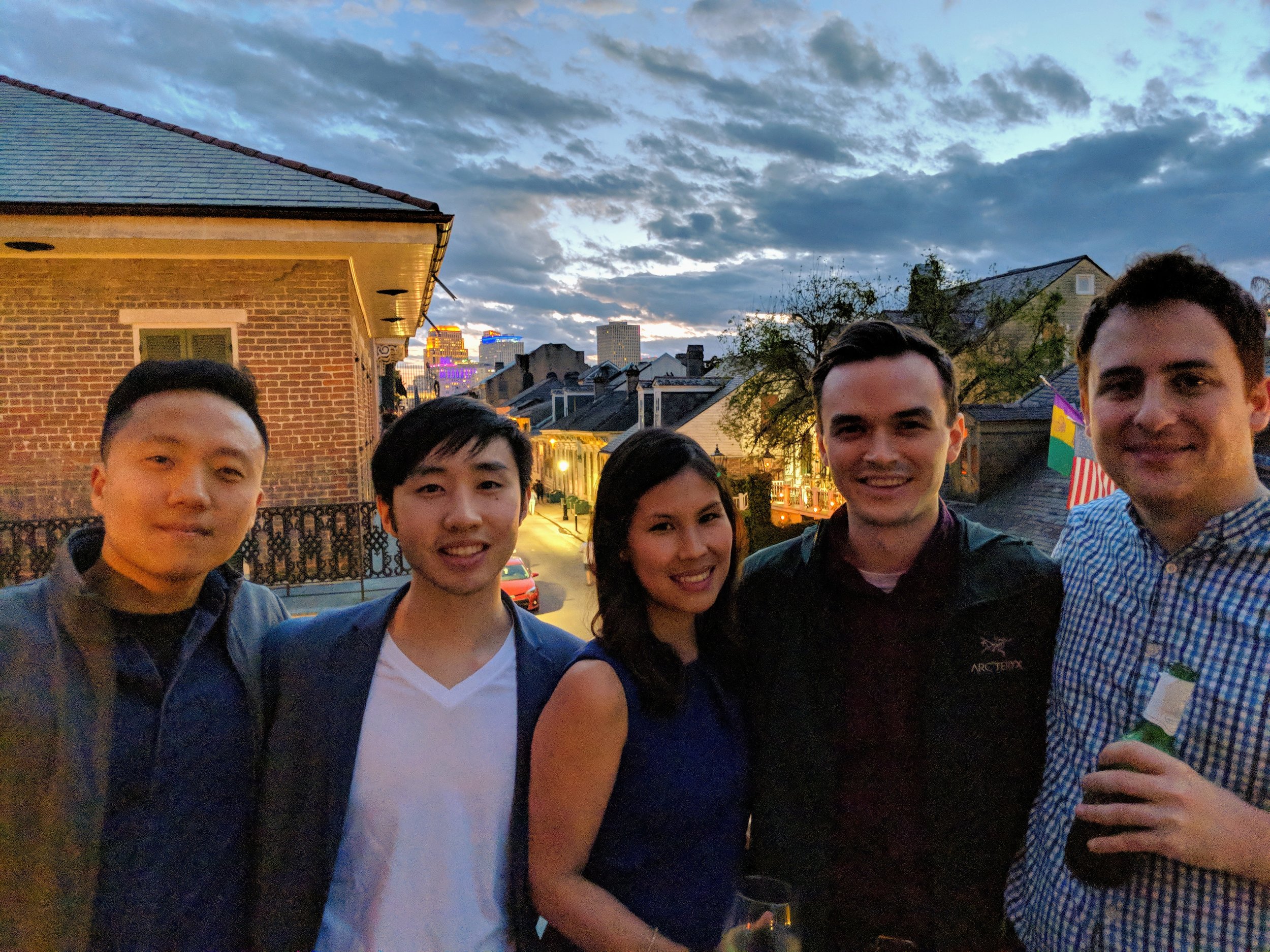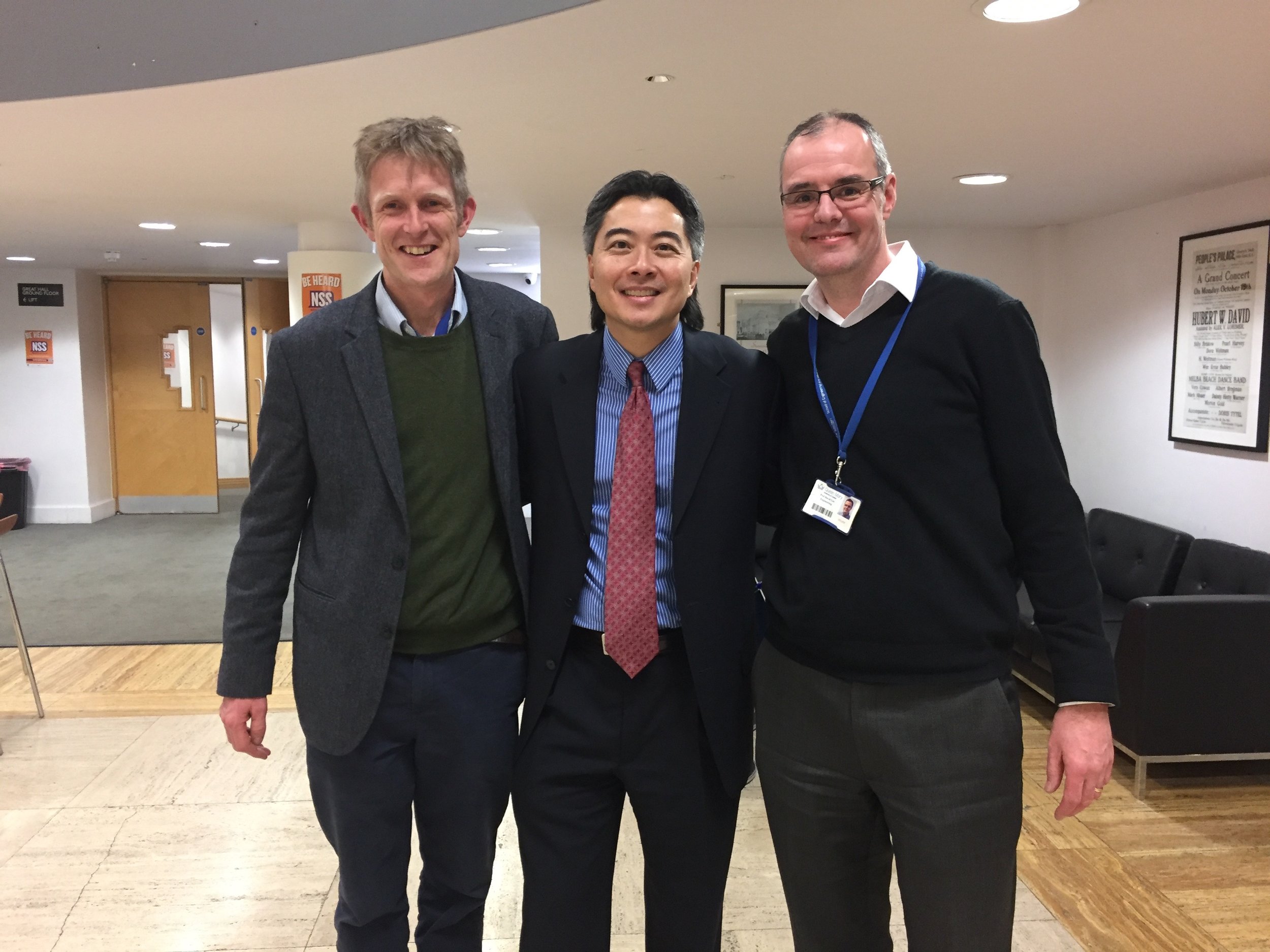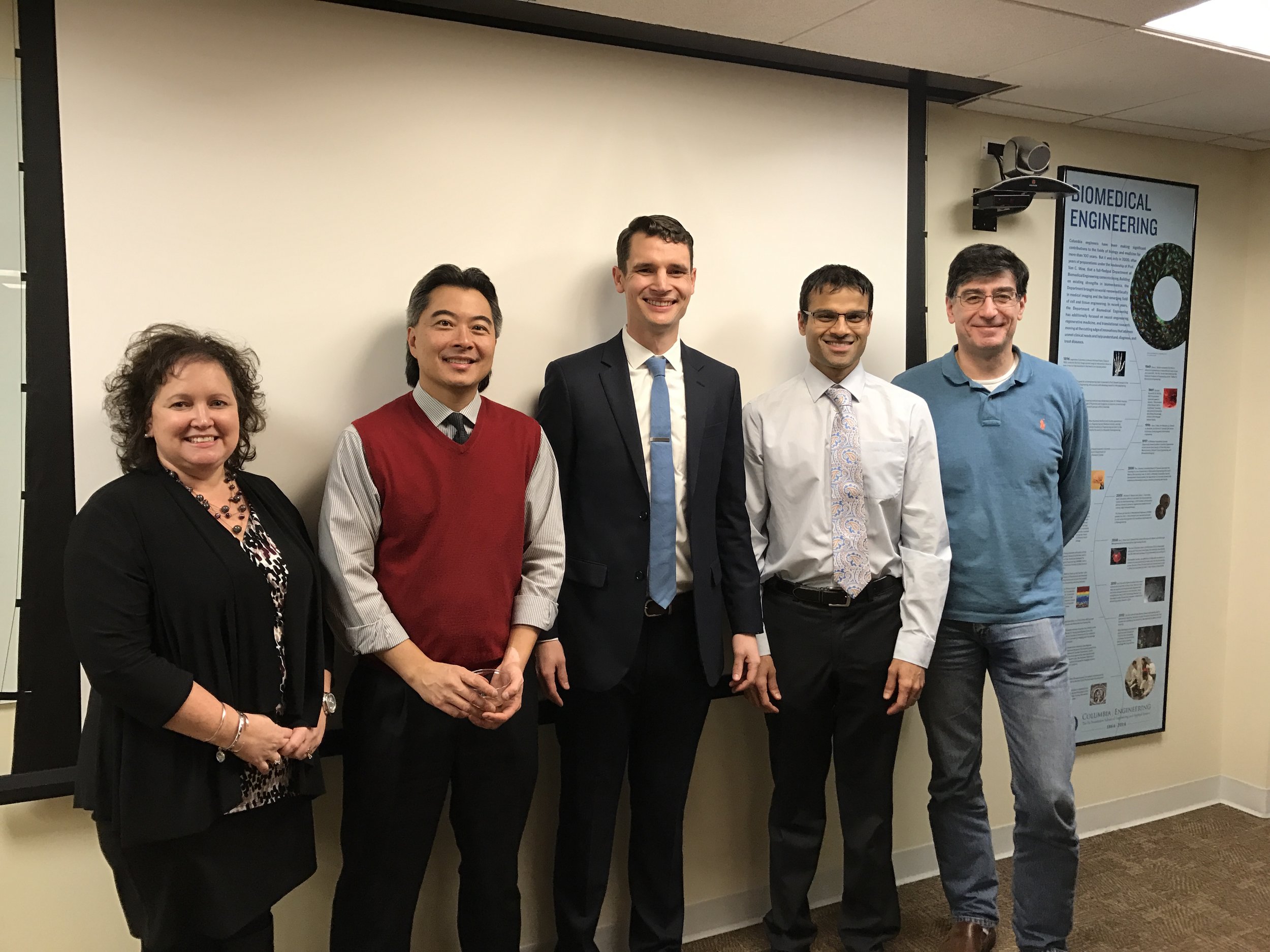Keep up the great work, Lance!
Keep up the great work, Lance!
Cellular Engineering Laboratory graduate students Robert Stefani and Eben Estell gave podium presentations at the Orthopedic Research Society Annual Meeting in New Orleans. Associate research scientist Dr. Andrea Tan, graduate student Jae Han Lee, and research assistant William Yu presented posters of their research during the meeting.

Unwinding on the Bourbon Street balcony of Dr. Eddie Schwartz. Thank you for hosting us!
On Saturday, October 21, 2017, CEL hosted high school students from the Bridge to Enter Advanced Mathematics (BEAM) program as they learned about topics "Inside Engineering." With diabetes as a disease model, students were introduced to the potential for using hydrogel beads and capsules for therapeutic approaches to manage the disease. Students participated in a hands on experiment making solid alginate beads that can be used for cell or drug delivery.
Alginate is a biopolymer hydrogel that is able to crosslink internally and externally to form alginate beads and capsules. After this formation, alginate can be used to encapsulate cells which protects them from immune cells and release of cell products.



Sofia Barbosa '20 and Lance Murphy '18 attended the International Seminar for Engineering Leaders, held at Pontificia Universidad Católica de Chile in Santiago, Chile from September 24-30, 2017. They are two of three engineering undergraduates representing Columbia University at the conference, which was attended by 800 students from around the globe.
Sofia (mentored by Andrea Tan) and Lance (mentored by Eben Estell) gave an oral presentation on their lab research examining the effects of cell synchronization on cellular mechanotransduction and biosynthetic output in tissue engineered cartilage.
Check out their introductory video, explaining their motivations for research and representing Columbia at the conference!

Saiti Halder '19 (mentored by Rob Stefani) presented her summer research at the Annual Science and Engineering Research Symposium on September 28, 2017. Saiti shared our ongoing work in developing a tissue engineered synovium model with fellow students from the Undergraduate Scholars Program and faculty from the Engineering School.
Modeling Cellular and TIssue Specific Phenotypic Changes in Osteoarthritic Synovium Using a Tissue Engineered Co-Culture System
Osteoarthritis (OA) is a common disease, affecting more than 3 million people in the US per year. Although cartilage degeneration has been a key focus of OA research for years, recently there is growing appreciation for the intimate role that synovium plays in diarthrodial joint health. Despite the critical role of the synovium in governing joint homeostasis, there is surprisingly little known about the mechanisms that underlie this function. Previous research has led to the creation of tissue engineered synovium that primarily contains fibroblast-like synoviocytes (FLS). While it is clear that FLS are able to organize into a synovium-like architecture and perform other critical aspects of the native synovium, our previous research on native synovium explants has indicated that macrophages are a critical part of this model. In this project, we build upon the previous model by incorporating both macrophages and fibroblasts. Our results indicate that it is possible to co-culture FLS and macrophages in the same tissue engineered construct. To compare the behavior of the tissue engineered synovium to the native synovium, we treated the tissue engineered synovium with different inflammatory cytokines and anti-inflammatory drugs that we previously used to characterize the explants. It was observed that interleukin-1 and/or dexamethasone treatment differentially modulates FLS and synovial macrophage (SM) content in a tissue engineered synovium model.
Thesis committee members included (left to right): Dr. Roshan Shah, Dr. Clark Hung, Dr. Gerard Ateshian, and Dr. Helen Lu. Dr. Bulinski not pictured.
CEL lab members celebrating Amy's defense (left to right): Clark Hung, Charlie Cai, Colden Lyons, Lance Murphy, Amy Silverstein, Evie Sobczak, Rob Stefani, Andrea Tan, Will Yu, Eben Estell, Saiti Holder, Krista Durney, Gerard Ateshian
Amy successfully defended her PhD thesis "Development of Biofidelic Culture Models of Osteoarthritis." Congratulations Dr. Silverstein!
Thesis Abstract: Osteoarthritis (OA) is a debilitating degenerative joint disease affecting 27 million Americans over the age of 25. Whereas OA is a disease of the entire joint organ, the contribution of the synovium, a specialized lining that envelops the knee joint, to cartilage degeneration and disease progression has been underappreciated. Synovial inflammation often precedes the development of cartilage damage and is observed in early and late stage OA. The onset of synovitis is driven by both elevated concentrations of pro-inflammatory cytokines and tissue debris in the joint space. Accordingly, surgeons have observed cartilaginous debris embedded within the synovium of OA patients presenting with severe synovial hyperplasia. It has been hypothesized that the fibrotic shortening of the synovial capsule results in OA pain and joint stiffness and contributes to further joint destruction through the release of degradative enzymes. Current strategies to treat synovial inflammation and joint pain, such as intra-articular injections and synovectomy, have had limited and variable success.
To this end, cell and tissue engineering culture models provide a versatile platform to study the tissues and cells involved in OA. Our lab has typically employed mechanical overload or cytokine insult of chondrocytes and cartilage explants to study cartilage degradation. Similarly, to isolate the role of synovium in OA, synovial explants or fibroblast-like synoviocytes (FLS) can be exposed to chemical or physical OA stimuli. Although often overlooked as an instigator of OA, cartilage wear particles have been reported to induce synovial inflammation and OA-like joint changes in various animal models. As opposed to non-biologic (metal or plastic) wear particles, small (sub-10mm) cartilage wear particles are comprised of extracellular matrix constituents that are degradable and may interact with cells beyond phagocytosis. Using cells derived from the pathologic joint provides the opportunity to study inherent changes to OA cells (both FLS and chondrocytes) within their own de novo extracellular matrix. The work presented in this dissertation aims to combine knowledge from basic science and pre-clinical culture models of OA to develop a clinically relevant disease model using cells derived from clinical samples.


A group of 25 9th-10th grade girls from NYC visited CEL to learn about Tissue Engineering and STEM at Columbia. After hearing a brief overview of CEL's work with cartilage repair and hydrogel systems, students participated in a hands-on lesson making different sized alginate beads by varying experiment parameters.

Clark Hung (center) with Martin Knight (left) and David Lee (right)
Dr. Clark Hung was invited to speak at Queen Mary University of London and Imperial College London. Hosted by Drs. Martin Knight (Professor of Mechanobiology) and David Lee (Professor of Cell and Tissue Engineering and Dean for Research) at Queen Mary University of London, Dr. Hung shared recent findings in engineering cartilage using cells from expired human donor grafts. He also discussed new strategies for cartilage repair including the use of a novel dexamethasone delivery system and electrotherapeutics. Furthermore, as osteoarthritis is believed to be a disease of the entire joint, additional focus was spent on in vitro disease models involving engineered synovium and parameters that modulate the injury response.

Gerard Ateshian with MBL alum Alex Cigan
Congratulations to Dr. Ateshian (director of Musculoskeletal Biomechanics Laboratory, MBL) on winning a top honor from the American Society of Mechanical Engineers (ASME). Dr. Ateshian was awarded the Lissner Medal for his "outstanding contributions to theoretical formulations and experimental investigations of cartilage mechanics and tissue engineering, and for pivotal contributions to the implementation and dissemination of open-source finite element computational tools for the biomechanical analysis of living tissues.” His research is focused on developing better modalities for the treatment of osteoarthritis, such as stronger engineered cartilage for resurfacing knee, hip, and shoulder joints.
Dr. Ateshian will be recognized at the 2017 Summer Biomechanics, Bioengineering, and Biotransport Conference in Tucson, Arizona in June. Congratulations Gerard!

Thesis committee members included (left to right): Dr. Kacey Marra, Dr. Clark Hung (advisor), Dr. Roshan Shah, and Dr. Gerard Ateshian (chair).

CEL lab members (left to right): Eben Estell, Clark Hung, Brendan Roach, Andrea Tan, Amy Silverstein, Charlie Cai, Rob Stefani
Brendan successfully defended his PhD thesis "Modulation of the in vitro mechanical and chemical environment for the optimization of tissue-engineered articular cartilage." Congratulations Dr. Roach!
Thesis Abstract: Articular cartilage is the connective tissue lining the ends of long bones, providing a dynamic surface that bears load while providing a smooth surface for articulation. When damaged, however, this tissue exhibits a poor capacity for repair, lacking the lymphatics and vasculature necessary for remodeling. Osteoarthritis (OA), a growing health and economic burden, is the most common disease afflicting the knee joint. Impacting nearly thirty million Americans and responsible for approximately $90 billion in total annual costs, this disease is characterized by a progressive loss of cartilage accompanied by joint pain and dysfunction. Moreover, while generally considered to be a disease of the elderly (65 years and up), evidence suggests the disease may be traced to joint injuries in young, active individuals, of whom nearly 50% will develop signs of OA within 20 years of the injury. For these reasons, significant research efforts are directed at developing tissue-engineered cartilage as a cell-based approach to articular cartilage repair. Clinical success, however, will depend on the ability of tissue-engineered cartilage to survive and thrive in a milieu of harsh mechanical and chemical agents.
To this end, previous work in our laboratory has focused on growing tissues appropriate for repair of focal defects and entire articular surfaces, thereby investigating the role of mechanical and chemical stimuli in tissue development. While we have had success at producing replacement tissues with certain qualities appropriate for clinical functionality, engineered cartilage capable of withstanding the full range of insults in vivo has yet to be developed. For this reason, and in an effort to address this shortcoming, the work described in this dissertation aims to (1) further characterize and (2) optimize the response of tissue-engineered cartilage to physical loading and the concomitant chemical insult found in the injured or diseased diarthrodial joint, as well as (3) provide a clinically relevant strategy for joint resurfacing. Together, this holistic approach maximizes the chances for in vivo success of tissue-engineered cartilage.



The Cuban official delegation from the Ministry of Higher Education visited CEL on October 27, 2016. Led by the deputy minister, Aurora Fernandez, the rector of the Technological University of Havana (Cujae), Alicia Alonso Becerra, and Luis Javier Baro, First Secretary at Permanent Mission of Cuba to the UN, the island educators met with leaders and members of various universities and government entities in the sector to explore areas of bilateral cooperation.
We shared our lab's efforts in cartilage tissue engineering, further fostering biomedical engineering across our two universities.


William T. Yu, SEAS '17, was invited to present his summer research in the undergraduate session at the BMES 2016 Annual Meeting in Minneapolis, Minnesota. Will presented on our ongoing work looking at strategies for increasing collagen content in engineered cartilage and is mentored by Andrea Tan. Congratulations Will!